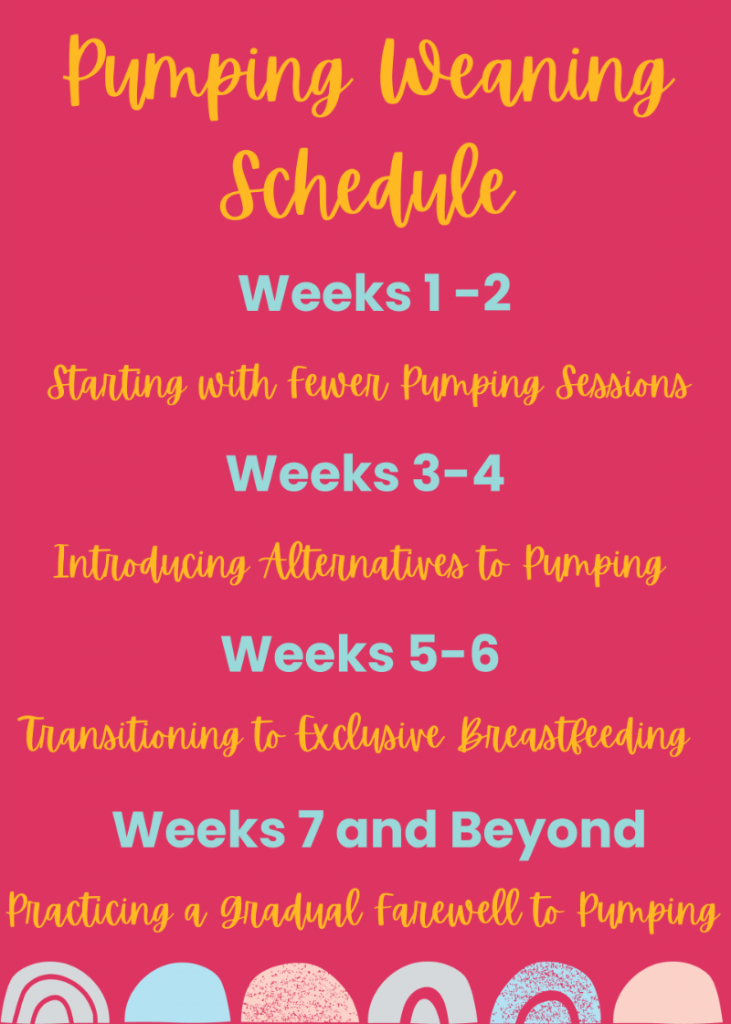Table of Contents
- Breastfeeding vs. Pumping
- How to Know When to Stop Pumping
- How Long Does It Take to Wean Off Pumping?
- Practicing a Gradual Transition
- The Pumping Weaning Schedule
- How to Wean Off Pumping: A Step-by-Step Guide
- Navigating the Bumps: Your Guide to Dealing with Clogged Milk Ducts
- How to Dry Up Breast Milk Naturally
- Addressing Potential Feelings of Guilt or Anxiety
- Saying Goodbye to Pumping and Hello to a New Chapter
A new chapter begins as the sun sets on the hum of your trusty breast pump. Learning how to wean off pumping is a pull between letting go and the promise of rediscovering yourself beyond expressing milk.
Whether you’re a seasoned mom or a first-time parent, bidding farewell to pumping comes with many emotions and questions. There is a palpable desire for a roadmap through this transition. So, we’ve crafted this guide to help you navigate weaning off pumping with grace and wisdom.
Breastfeeding vs. Pumping
Breastfeeding, like a warm hug, nourishes your little one and weaves an unbreakable bond between you two. The quiet moments, the shared glances, and the feeling of closeness make this experience worthwhile.
Now, enter the breast pump—the unsung hero of multitasking moms everywhere. It’s a partner in crime, allowing you to create a harmonious blend of motherhood and the rest of your life. Pumping introduces flexibility, letting you share feeding duties with your partner. It also ensures the baby gets all the nutrients even when you’re away, and, let’s face it, gives you a little bit of well-deserved freedom.
Breastfeeding and pumping create a dynamic duo, a powerful force that sustains you and your child. But as the chapters of motherhood unfold, so do these routines. And thus, the time comes to decide to wean off pumping.
How to Know When to Stop Pumping
Choosing to wean off pumping requires careful consideration, a touch of intuition, and some advice from friends. The decision-making is about finding the sweet spot where your unique circumstances blend with your baby’s evolving needs. It’s asking, “Is it time to switch up the routine and let the pump take a backseat?”
Going cold turkey might be tempting, but a gradual approach ensures a smoother transition for you and your baby. Finding a technique that respects your needs and your baby’s evolving appetite is best.
You must look for the following flags to help you decide if it’s time to wean off the pump.
The Baby’s Expressive Palette
Pay attention to your little one’s cues. Is your baby showing more interest in solid foods? Are they making direct eye contact with the spoon? Perhaps they’re doing a little victory dance after each meal. If you’ve noticed these behaviors, it might be their way of saying, “Mom, let’s move beyond the bottle.”

The Bottle Side-Eye
Is your once bottle-loving baby giving the side-eye to the thing that used to comfort them? Suppose they’re showing less enthusiasm for bottle feeds and are yearning for those tender moments of direct breastfeeding. In that case, it’s a sign that their preferences are evolving.
Your Lifestyle Unraveling
Consider the rhythm of your daily life. Is the pump starting to feel like a not-so-pleasant reminder of your breastfeeding journey? If untangling yourself from the milk machine is beginning to seem more liberating than entwining, it might indicate that you’re ready for the next parenting chapter.
The Baby’s Nutritional Needs
As your little one grows, their nutritional needs and preferences mature. If your baby has started exploring the world of solids and is now more fond of mashed bananas and sweet potatoes, it’s a sign that their palate is expanding. The pump might not be the star of the show anymore.
How Long Does It Take to Wean Off Pumping?
Ah, the million-dollar question on the minds of every mom ready to say goodbye to pumping. The truth is, there’s no one-size-fits-all answer. It’s not a race against the clock but rather a gentle waltz between you and your little one.
The pumping weaning schedule can span anywhere from a few weeks to a few months. It’s about finding your rhythm, understanding your baby’s cues, and allowing the transition to unfold organically. Rushing it may leave you feeling out of sync. So embrace the pace that feels right for both of you.
Factors Influencing the Weaning Stage’s Duration
Now, let’s dive into the factors that dictate your weaning off pumping schedule.
Baby’s Age and Feeding Patterns
If your baby has started exploring solids and is less reliant on frequent feeds, the weaning process might be faster. It’s about tuning into your baby’s unique needs and adjusting accordingly.
Pumping Frequency
The number of times you pump daily plays a role in the duration. If you’ve been pumping frequently, the duration will likely take longer.
Your Milk Supply
Another factor is your body’s response to the gradual reduction in pumping sessions. Some moms experience a more gradual decline in milk supply, while others might find their supply adjusts more quickly. Each body has a different reaction; the weaning-off process is uniquely yours.
Comfort Level of Mom and Baby
If you and your baby are comfortable with the gradual reduction, the process tends to flow more smoothly. Trust your instincts, listen to your baby’s cues, and let the comfort of the transition guide your journey.
Practicing a Gradual Transition
A gradual transition is more than just a suggestion. It helps ensure a harmonious weaning-off experience for you and your little one. Slowly lessening the pumping sessions allows your body to adjust at its own pace. It not only minimizes discomfort, engorgement, and the risk of clogged milk ducts but also provides a mental and emotional cushion for you.
Additionally, taking things one step at a time lets your baby adjust to the evolving feeding pattern. It eliminates the jarring shock of an abrupt change. It also respects their cues and nurtures a seamless switch from bottle to breast.
Think of the weaning off process as an opportunity for additional bonding moments with your baby. Direct breastfeeding sessions become more intentional, filled with eye contact, gentle touches, and the warmth of shared closeness. This gradual transition isn’t just about stopping pumping; it’s about embracing a new, more intimate chapter in your breastfeeding journey.
The Pumping Weaning Schedule
Creating a specific weaning-off pumping timeline can be challenging. You must consider several factors, including your baby’s age, feeding habits, and comfort level. However, here is a generalized example that you can adapt based on your unique circumstances.

Starting with Fewer Pumping Sessions (Week 1-2)
- Days 1-3: Start by reducing the number of pumping sessions to one per day. If you were pumping four times a day, aim for three sessions.
- Days 4-7: Continue with three pumping sessions daily. Pay attention to your body’s response and your baby’s feeding cues.
- Days 8-14: Gradually reduce to two pumping sessions each day. Observe how your milk supply adjusts and ensure your baby is comfortable with the pace.
Introducing Alternatives to Pumping (Weeks 3-4)
- Days 15-21: Cut down to one pumping session per day. Focus on direct breastfeeding when possible and introduce alternative feeding methods like a cup or spoon for supplementary feeds.
- Days 22-28: Begin skipping a day between pumping sessions. If you were pumping every day, try pumping every other day. Monitor your baby’s satisfaction with breastfeeding and other feeding methods.
Transitioning to Exclusive Breastfeeding (Weeks 5-6)
- Days 29-35: If you’ve been pumping every other day, extend the gap to two days between sessions. Continue focusing on direct breastfeeding and alternative feeding.
- Days 36-42: Aim to pump once every three days. By this point, your milk supply should naturally decrease as your baby adjusts to more exclusive breastfeeding.
Practicing a Gradual Farewell to Pumping (Week 7 and Beyond)
- Day 43 onward: Listen to your body and your baby. If you feel comfortable, consider stopping the last pumping session. Continue nurturing your breastfeeding bond, and monitor your baby’s contentment with this more exclusive feeding approach.
Remember, this is just a sample timeline, and it’s essential to tailor it to your circumstances. Pay attention to your body’s signals and your baby’s cues. It’s also best to consult with a healthcare professional if you have concerns or questions throughout the weaning-off process. Every mother-baby duo is unique, so your journey may follow a different tempo.
How to Wean Off Pumping: A Step-by-Step Guide
The ideal length for pumping sessions when weaning off can vary depending on your circumstances. However, a general guideline is gradually decreasing pumping time throughout the weaning process. Here’s a suggested approach:
- Start with your regular pumping time: If you have been pumping for, let’s say, 15-20 minutes per session, maintain this duration for the initial part of your weaning journey.
- Reduce pumping time gradually: Aim to shave off a minute or two from each pumping session every few days. For instance, if you’ve been pumping for 20 minutes, try reducing it to 18 minutes for a few days, then down to 15 minutes, and so on.
- Monitor your comfort and milk supply: Pay close attention to how your breasts feel during and after pumping, and keep an eye on your milk supply. If you notice any discomfort or a decrease in milk production, you may need to adjust the pace of reduction.
- Continue adjusting based on your body’s response: As you decrease the pumping time, your body should gradually produce less milk. Adjust the duration according to your comfort level and your baby’s feeding needs.
Navigating the Bumps: Your Guide to Dealing with Clogged Milk Ducts
One of the downsides of weaning off pumping is a clogged milk duct. It can be stressful, but fortunately, you can manage it with practical techniques.
Understanding the Causes and Symptoms of Clogged Ducts
So, what exactly is a clogged milk duct? Think of it as a traffic jam in your milk duct system. When milk isn’t flowing freely, it can cause a blockage, leading to discomfort, tenderness, and sometimes pain. Here are a few common causes of this condition:
- Infrequent Emptying: If your breast isn’t fully emptied during feeds or pumping sessions, it can pave the way for clogs.
- Pressure on the Ducts: Ill-fitting bras, tight clothing, or even sleeping in a position that compresses your breasts can contribute to clogged ducts.
- Sudden Changes in Feeding Patterns: As you wean off pumping, abrupt changes in your baby’s feeding patterns can impact the flow of milk.
Meanwhile, here are the symptoms you need to keep an eye out for:
- Localized Pain: You might notice a tender spot or a lump in your breast.
- Redness and Swelling: The affected area might appear redder and feel warmer than usual.
- Discomfort During Feeds: Breastfeeding or pumping may become uncomfortable or painful.
Reducing the Risk of Clogged Ducts During Weaning
Now, let’s talk about preventive measures because, let’s face it, an ounce of prevention is worth a gallon of breast milk. As you gracefully navigate the waters of weaning, here’s how to steer clear of those pesky clogs:

- Maintain Consistent Emptying: Whether through breastfeeding or pumping, ensure your breasts are regularly emptied to minimize the risk of blockages.
- Adjust Feeding Positions: Experiment with different breastfeeding positions to encourage thorough drainage of your breasts. A good latch is not just a comfort thing; it’s your secret weapon against clogged ducts.
- Stay Hydrated and Nourished: A well-hydrated and well-nourished body is less prone to clogs. Keep that water bottle handy and indulge in those nutrient-packed snacks.
- Dress for Comfort: Embrace comfy, loose-fitting clothing and ensure your bras are supportive without being too constricting. Your breasts deserve to breathe freely.
Remedies and Techniques for Relieving Clogged Ducts
If you find yourself in the midst of clogged ducts, worry not. Here are some battle-tested remedies and techniques to ease the discomfort while you’re learning how to wean off pumping.
- Warm Compress: Place a warm compress to the sore area before feeds or pumping sessions.
- Gentle Massage: During feeds or while pumping, gently massage the lump towards the nipple.
- Frequent Feeds: Encourage your baby to feed more frequently on the affected side. The increased suckling can help break up the clog.
- Expressing After Feeds: If you’re still pumping during the weaning process, try expressing a little milk after feeds to ensure thorough emptying.
- Rest: Get enough rest, and allow your body the time it needs to recover.

When to Seek Professional Help for Persistent Issues
Sometimes, you need to call in the experts when your situation gets rough. If you find that the clogged duct isn’t easing up despite your best efforts, it’s time to signal for help. Seek professional assistance if:
- The clog persists: If the clogged duct persists for more than a few days despite home remedies, it’s time to consult with a healthcare professional.
- Symptoms intensify: If you notice an increase in redness, swelling, or pain, it’s crucial to visit a doctor.
- Fever develops: A fever could indicate an infection and prompt medical attention is necessary.
How to Dry Up Breast Milk Naturally
The ultimate goal is to let the milk dry up so you can say goodbye to pumping for good. Here are some natural techniques to help you ease into this transition:
Gradual Weaning: As you’ve been doing with pumping, consider gradually reducing the number of breastfeeding or pumping sessions. It allows your body to adjust to the decreasing demand without the shock of a sudden halt.
Shortening Feeds or Pumping Sessions: Instead of abruptly stopping, try shortening the duration of each feeding or pumping session.
Offer Alternatives: Introduce alternative feeding methods such as formula or expressed milk in a cup or bottle. This hack not only helps your baby transition but also reduces the stimulation to your breasts.
Comfort Measures: Use cold compresses on your breasts to help relieve engorgement and reduce milk production.
Supportive Bras: Invest in comfortable, supportive bras to help minimize discomfort and reduce breast stimulation.
Self-Care to Ease Discomfort During the Drying-Up Process

Drying up breast milk is not just a physical but also an emotional journey. Here are some self-care rituals to accompany you on this expedition:
- Soak in warm baths to help alleviate breast discomfort.
- Massage your breasts during a warm shower to relieve engorgement.
- Ensure you’re staying well-hydrated and maintaining a balanced diet.
- Embrace extra rest during this transition.
- Allow yourself to express any emotions during this process – relief, nostalgia, or a mix of both.
- Drink herbal teas, such as peppermint or sage, traditionally used to help reduce milk supply. However, it’s vital to consult with your doctor before incorporating these into your routine.
- Include food rich in omega-3 fatty acids, like flaxseeds or fatty fish, to support your overall well-being as your milk supply dwindles.
Seeking Guidance from a Medical Professional If Needed
While these natural methods and self-care practices can offer support during the drying-up process, it’s essential to remember that every mother’s journey is unique. Seek a healthcare professional if you encounter persistent discomfort, emotional challenges, or concerns.
A lactation consultant can provide personalized guidance based on your circumstances. They can offer strategies for managing discomfort and address any challenges you may face.
If you experience severe pain, signs of infection, or emotional distress during the drying-up process, don’t hesitate to contact your healthcare provider. They can offer medical advice and ensure you’re navigating this transition healthily.
Addressing Potential Feelings of Guilt or Anxiety
As you approach the prospect of weaning off pumping, it’s natural for a sea of emotions to ripple through. Guilt and anxiety may emerge, and that’s perfectly okay. Here are ways to navigate these feelings.
Begin by acknowledging that feeling guilt or anxiety is a common part of the weaning process. Accept that these emotions are valid and, in fact, a testament to the depth of your connection with your baby.
It would also help to understand that many mothers encounter similar emotions when weaning off pumping. It’s not a sign of inadequacy, but rather, it’s a profound emotional investment you’ve made in nourishing your little one.
Strategies for Coping with Weaning Off Pumping Emotions
Embracing the emotional tide of weaning off pumping is a voyage of self-discovery. Here are strategies to navigate the waves and find solace in this transition:
- Create Rituals: Establish meaningful rituals to mark the end of pumping sessions. It could be a quiet moment of reflection, lighting a candle, or capturing the last pump session in a photo. Rituals provide closure and allow you to express your emotions in a tangible way.
- Practice Self-Compassion: Be kind to yourself during this transition. Understand that weaning off pumping doesn’t diminish your role as a nurturing mother.
- Celebrate Milestones: Every last pump session, every successful breastfeeding without the pump, and every smile from your baby are milestones worth celebrating.
- Focus on the Bond: Redirect your attention to the deepening bond with your baby. Embrace the newfound closeness that comes with direct breastfeeding. It’s a chance to savor the intimate moments that define the heart-to-heart connection.
- Celebrate Freedom and Flexibility: Embrace the newfound freedom and flexibility of weaning off pumping. No more scheduling your day around the pump’s rhythmic hum—you have the option to respond to your baby’s cues at the moment.
- Self-Rediscovery: As the parenting journey evolves, take a moment to rediscover aspects of yourself that may have taken a backseat during the pumping era. It’s an opportunity for self-renewal and personal growth.
- Communicate: Share your feelings with your partner, friends, or fellow moms. Sometimes, expressing your emotions can alleviate the weight of guilt or anxiety. You’ll likely find a chorus of understanding voices.
Saying Goodbye to Pumping and Hello to a New Chapter
As our exploration of weaning off pumping draws to a close, take a moment to reflect on the journey behind and the horizon ahead. You’ve been the captain of this unique motherhood experience, and having mixed feelings about ending it is understandable. Remember that weaning off pumping isn’t a farewell; it’s a transition to a new chapter and new milestones.
It would help to embrace the newfound freedom. You enjoy relishing quality time with your baby and rediscovering aspects of yourself that have patiently awaited your attention.
Head to our comment box down below to share your tips on how to wean off pumping. Your journey is unique, and by sharing, you can help other mothers navigate these uncertain times. Let your stories ripple through the waves, creating a legacy of love, resilience, and the beautiful cadence of motherhood.
Like this post? Click the image below to save it on Pinterest -Thank you!











